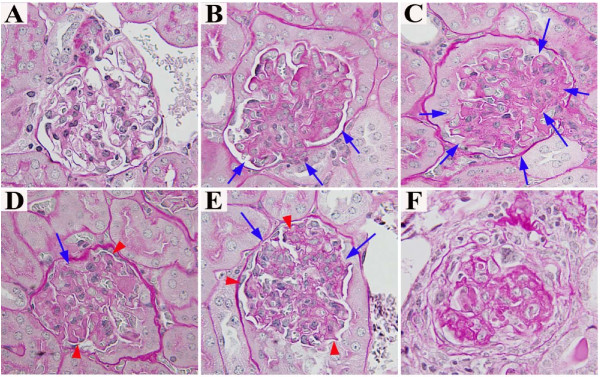Figure 7.
Representative histopathology for mice of the three MRL/lpr γ3 heavy chain genotypes. At 18 weeks of age, a small minority (~12%) of the glomeruli in each genotype appeared normal (panel A). The most prevalent glomerular pattern (66-76% of glomeruli) at 18 weeks in mice of all three γ3 heavy chain genotypes was segmental (panel B) or global (C) acute endocapillary proliferative glomerulonephritis, wherein some or most glomerular capillaries are narrowed by increased numbers of cells (blue arrows), without changes in the glomerular basement membranes. In γ3 -/- mice at 26 weeks of age, and in γ3 +/+ and +/- mice at 21 weeks of age, chronic endocapillary proliferative glomerulonephritis (panel D, from a γ3 -/- mouse at 26 weeks, and panel E, from a γ3 +/- mouse at 26 weeks) was most prevalent; in these glomeruli, thickening and tortuosity of basement membranes (red arrowheads) is superimposed upon persistently increased endocapillary cellularity (blue arrows). Sclerosis, characterized by collapse, marked thickening and tortuosity of glomerular basement membranes, that occludes capillary lumens and distorts glomerular architecture (panel F), was the most prevalent pattern (67-79%) in glomeruli in +/+ and +/- mice at 26 weeks. In contrast, scarring evident as irreversible glomerulosclerosis was relatively infrequent (≤ 22%) in -/- mice at all time points.

